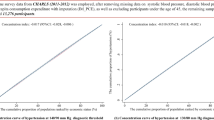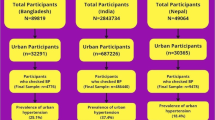Abstract
This study aimed to assess the association between the trend of urban–rural disparity in high blood pressure (HBP) in Chinese children and adolescents and socioeconomic development. Data on 1,054,602 students aged 7–18 years were obtained from five successive national surveys administered in 29 Chinese provinces in 1995, 2000, 2005, 2010, and 2014. HBP was defined as average measured systolic BP and/or diastolic BP equal to or more than 95th percentile. The socioeconomic indicators at the provincial-level included gross domestic product (GDP) per capita, the Engel coefficient, and urbanization rates. From 1995 to 2014, HBP prevalence in Chinese children and adolescents fluctuated between 6.9% and 9.2%. Rural areas had a higher prevalence of HBP than urban areas, with a diminishing trend in urban–rural disparity from 1995 to 2010 with a reduced OR from 1.45 (95% CI: 1.40–150) in 1995 to 1.09 (1.05–1.12) in 2010, whereas a widening gap in 2014 with OR of 1.23 (1.19–1.26)). A positive association existed between the improvement of socioeconomic indicators and the increase in HBP, which was demonstrated obviously by the Engel coefficient strata. The increases in the urbanization rates were accompanied by a greater increase of HBP in urban than in rural areas. The large urban–rural disparity suggests a priority of HBP control in rural children due to their current and future HBP and cardiovascular disease risks. Socioeconomic development could affect the urban–rural disparity in HBP risk, reflecting the importance of effective policy responses for preventing HBP by avoiding unhealthy lifestyles brought about by rapid economic development.
This is a preview of subscription content, access via your institution
Access options
Subscribe to this journal
Receive 12 digital issues and online access to articles
$119.00 per year
only $9.92 per issue
Buy this article
- Purchase on Springer Link
- Instant access to full article PDF
Prices may be subject to local taxes which are calculated during checkout



Similar content being viewed by others
Availability of data and material
The datasets and result computational code used and analyzed during the current study are available from the corresponding author on reasonable request.
References
Li Y, Wang DD, Ley SH, Howard AG, He Y, Lu Y, et al. Potential impact of time trend of life-style factors on cardiovascular disease burden in China. J Am Coll Cardiol. 2016;68:818–33.
Lacey B, Lewington S, Clarke R, Kong XL, Chen Y, Guo Y, et al. Age-specific association between blood pressure and vascular and non-vascular chronic diseases in 0.5 million adults in China: a prospective cohort study. Lancet. Glob Health. 2018;6:e641–9.
Ingelfinger JR. The child or adolescent with elevated blood pressure. N Engl J Med. 2014;370:2316–25.
Chen X, Wang Y. Tracking of blood pressure from childhood to adulthood: a systematic review and meta-regression analysis. Circulation 2008;117:3171–80.
Daniels SR, Pratt CA, Hayman LL. Reduction of risk for cardiovascular disease in children and adolescents. Circulation 2011;124:1673–86.
Ogunsina K, Dibaba DT, Akinyemiju T. Association between life-course socio-economic status and prevalence of cardio-metabolic risk ractors in five middle-income countries. J Glob Health. 2018;8:020405.
NCD Risk Factor Collaboration. Worldwide trends in blood pressure from 1975 to 2015: a pooled analysis of 1479 population-based measurement studies with 19.1 million participants. Lancet . 2017;389:37–55.
Jaacks LM. The unintended consequences of economic growth on child and adolescent nutrition. Lancet Diabetes Endocrinol. 2019;7:247–8.
Wilkinson RG, Pickett KE. The problems of relative deprivation: why some societies do better than others. Soc Sci Med. 2007;65:1965–78.
Dong Y, Jan C, Ma Y, Dong B, Zou Z, Yang Y, et al. Economic development and the nutritional status of Chinese school-aged children and adolescents from 1995 to 2014: an analysis of five successive national surveys. Lancet Diabetes Endocrinol 2019;7:288–99.
Dong B, Wang Z, Ma J. Urban-rural disparity in blood pressure among Chinese children: 1985-2010. Eur J Public Health. 2016;26:569–75.
Khang YH, Lynch JW. Exploring determinants of secular decreases in childhood blood pressure and hypertension. Circulation 2011;124:397–405.
Dong Y, Ma J, Song Y, Ma Y, Dong B, Zou Z, et al. Secular trends in blood pressure and overweight and obesity in Chinese boys and girls aged 7 to 17 years from 1995 to 2014. Hypertension. 2018;72:298–305.
M R. Income effects on undernutrition. Econ Dev Cult Change 1990;38:489–515.
Dong Y, Ma J, Song Y, Dong B, Wang Z, Yang Z, et al. National blood pressure reference for chinese han children and adolescents aged 7 to 17 years. Hypertension 2017;70:897–906.
Ji CY, Chen TJ. Working Group on Obesity in C. Empirical changes in the prevalence of overweight and obesity among Chinese students from 1985 to 2010 and corresponding preventive strategies. Biomed Environ Sci: Bes 2013;26:1–12.
National Bureau of Statistics of the People’s Republic of China. Statistical Yearbook of China. Beijing, 2015. (Accessed March 4, 2015, at: http://www.stats.gov.cn/tjsj/ndsj/).
Wikipedia. List of countries by GDP (PPP) per capita. (Accessed June 22, 2021, at:https://en.wikipedia.org/wiki/List_of_countries_by_GDP_(PPP)_per_capita).
Special Project on Poverty Statistics United Nations Statistics Division. Handbook on poverty statistics: concepts, methods and policy use. 2005. https://unstats.un.org/unsd/methods/poverty/pdf/un_book%20final%2030%20dec%2005.pdf.
WHO. WHO child growth standards: length/height-for-age, weight-for-age, weight-for-length, weight -for-height and body mass index-for-age: methods and development. 2006;1.
Hastie T, Tibshirani R. Generalized additive models for medical research. Stat Methods Med Res. 1995;4:187–96.
Noubiap JJ, Essouma M, Bigna JJ, Jingi AM, Aminde LN, Nansseu JR. Prevalence of elevated blood pressure in children and adolescents in Africa: a systematic review and meta-analysis. Lancet. Public Health. 2017;2:e375–86.
Yamamoto-Kimura L, Posadas-Romero C, Posadas-Sanchez R, Zamora-Gonzalez J, Cardoso-Saldana G, Mendez, et al. Prevalence and interrelations of cardiovascular risk factors in urban and rural Mexican adolescents. J Adolesc Health. 2006;38:591–8.
Amiri P, Vahedi-Notash G, Naseri P, Khalili D, Hashemi Nazari SS, Mehrabi Y, et al. National trends of pre-hypertension and hypertension among Iranian adolescents across urban and rural areas (2007–2011). Biol Sex Differ. 2019;10:15.
Hifzur R, Singh A. Socio-economic inequalities in the risk of diseases and associated risk factors in India. J Public Health Epidemiol. 2011;3:520–8.
Sommer I, Griebler U, Mahlknecht P, Thaler K, Bouskill K, Gartlehner G, et al. Socioeconomic inequalities in non-communicable diseases and their risk factors: an overview of systematic reviews. BMC Public Health. 2015;15:914.
Montez JK, Bromberger JT, Harlow SD, Kravitz HM, Matthews KA. Life-course socioeconomic status and metabolic syndrome among midlife women. J Gerontol B Psychol Sci Soc Sci. 2016;71:1097–107.
Stringhini S, Viswanathan B, Gedeon J, Paccaud F, Bovet P. The social transition of risk factors for cardiovascular disease in the African region: evidence from three cross-sectional surveys in the Seychelles. Int J Cardiol. 2013;168:1201–6.
Fateh M, Emamian MH, Asgari F, Alami A, Fotouhi A. Socioeconomic inequality in hypertension in Iran. J Hypertens. 2014;32:1782–8.
Leng B, Jin Y, Li G, Chen L, Jin N. Socioeconomic status and hypertension: a meta-analysis. J Hypertens. 2015;33:221–9.
Zhang Z, Dong B, Li S, Chen G, Yang Z, Dong Y, et al. Exposure to ambient particulate matter air pollution, blood pressure and hypertension in children and adolescents: a national cross-sectional study in China. Environ Int. 2019;128:103–8.
Din-Dzietham R, Liu Y, Bielo MV, Shamsa F. High blood pressure trends in children and adolescents in national surveys, 1963 to 2002. Circulation 2007;116:1488–96.
Freedman DS, Goodman A, Contreras OA, DasMahapatra P, Srinivasan SR, Berenson GS. Secular trends in BMI and blood pressure among children and adolescents: the Bogalusa Heart Study. Pediatrics 2012;130:e159–66.
Pickering T. Cardiovascular pathways: socioeconomic status and stress effects on hypertension and cardiovascular function. Ann NY Acad Sci. 1999;896:262–77.
Antignac M, Diop IB, Macquart de Terline D, Kramoh KE, Balde DM, Dzudie A, et al. Socioeconomic status and hypertension control in sub-Saharan Africa: the Multination EIGHT Study (Evaluation of Hypertension in Sub-Saharan Africa). Hypertension 2018;71:577–84.
McGovern ME, Krishna A, Aguayo VM, Subramanian SV. A review of the evidence linking child stunting to economic outcomes. Int J Epidemiol. 2017;46:1171–91.
Messer E. Intra-household allocation of food and health care: current findings and understandings-introduction. Soc Sci Med. 1997;44:1675–84.
Headey DD. Developmental drivers of nutritional change: a cross-country analysis. World Dev. 2013;42:76–88.
Dong Y, Song Y, Zou Z, Ma J, Dong B, Prochaska JJ. Updates to pediatric hypertension guidelines: influence on classification of high blood pressure in children and adolescents. J Hypertens. 2019;37:297–306.
Flynn JT, Falkner BE. New clinical practice guideline for the management of high blood pressure in children and adolescents. Hypertension 2017;70:683–6.
Flynn JT, Kaelber DC, Baker-Smith CM, Blowey D, Carroll AE, Daniels SR, et al. Clinical practice guideline for screening and management of high blood pressure in children and adolescents. Pediatrics 2017;140:e20171904.
Marmot M. Commission on Social Determinants of Health Achieving health equity: from root causes to fair outcomes. Lancet. 2007;370:1153–63.
Bixby H, Bentham J, Zhou B, Di Cesare M, Paciorek CJ, Bennett JE, et al. Rising rural body-mass index is the main driver of the global obesity epidemic in adults. Nature 2019;569:260–4.
Quon EC, McGrath JJ. Province-level income inequality and health outcomes in Canadian adolescents. J Pediatr Psychol. 2015;40:251–61.
Acknowledgements
The authors would like to acknowledge the support from all the team members and the participated students, teachers, parents, and local education and health staff in the programs.
Funding
The present study was supported by the National Natural Science Foundation (Grant 81673192 to Jun Ma) and Humanities and Social Sciences Planning Fund Project, Ministry of Education, People’s Republic of China (Grant 19YJA890022 to Yi Song), as well as project funded by the China Postdoctoral Science Foundation (National Postdoctoral Program for Innovative Talent, BX20200019 and 2020M680266 to Yanhui Dong). The funders did not play any roles in the design of the study and collection, analysis, and interpretation of data and in writing the manuscript.
Author information
Authors and Affiliations
Contributions
DYH conceptualized and designed the study, completed the statistical analyses, drafted the initial manuscript, and reviewed and revised the manuscript; MJ and SY contributed to the conceptualization and design of the study, supervised the data collection, the statistical analyses, and initial drafting of the manuscript, and reviewed and revised the manuscript; MC, BS, YL, DG, BW and assisted with the statistical analyses and reviewed the manuscript. All authors read and approved the final version of the manuscript.
Corresponding authors
Ethics declarations
Competing interests
The authors declare no competing interests.
Ethics approval and consent to participate
Informed consent was obtained from both parents and students before they participated in the study. The project was approved by the Medical Research Ethics Committee of Peking University Health Science Center (IRB00001052-13082).
Consent for publication
We have obtained consent to publish from both children and parents to report their data uninvolved in their privacy.
Additional information
Publisher’s note Springer Nature remains neutral with regard to jurisdictional claims in published maps and institutional affiliations.
Supplementary information
Rights and permissions
About this article
Cite this article
Dong, Y., Chen, M., Sun, B. et al. Trends in associations between socioeconomic development and urban–rural disparity with high blood pressure in Chinese children and adolescents over two decades. J Hum Hypertens 36, 866–874 (2022). https://doi.org/10.1038/s41371-021-00592-7
Received:
Revised:
Accepted:
Published:
Issue Date:
DOI: https://doi.org/10.1038/s41371-021-00592-7



